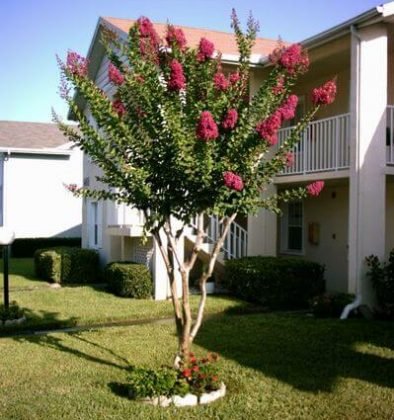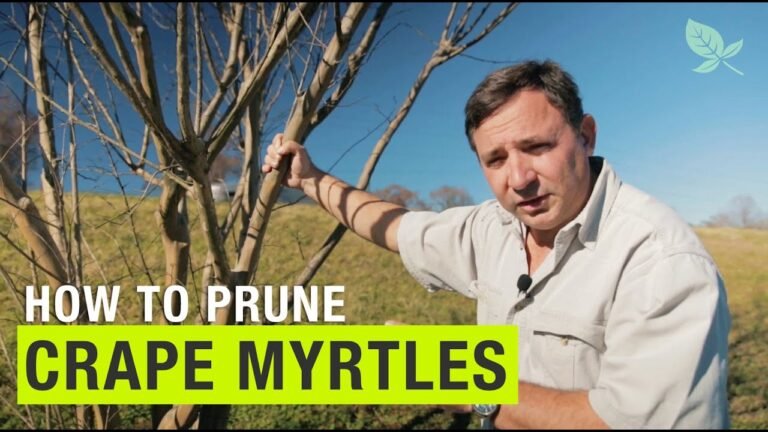The Art of Crape Myrtle Pruning- Comprehensive Guide

Crape myrtles (Lagerstroemia indica) are beloved ornamental shrubs and small trees known for their vibrant and long-lasting summer blooms. These versatile plants come in various sizes and colors, making them a popular choice among gardeners and landscapers alike. To ensure that your crape myrtles thrive and maintain their aesthetic appeal, proper pruning is essential. In this comprehensive guide, we will delve into the art of crape myrtle pruning, exploring when, why, and how to prune these beautiful plants.
Introduction to Crape Myrtles
Crape myrtles are native to various regions, including parts of Asia, Australia, and North America and they grow well in Florida. They are prized for their clusters of colorful, crepe-paper-like flowers, which can be found in a range of hues, including shades of pink, purple, red, and white. These plants come in a variety of sizes, from dwarf shrubs to towering trees, making them versatile for various landscapes.
Crape myrtles offer year-round interest. In addition to their dazzling summer blossoms, they feature stunning peeling bark that provides textural intrigue during the winter months. However, to maintain their beauty and health, proper Crape Myrtle pruning is crucial.
Why Prune Crape Myrtles?
Pruning crape myrtles serves multiple purposes, all of which contribute to the overall well-being and aesthetic appeal of the plant:
1. Encourage Healthy Growth
Pruning removes dead or diseased branches, which can help prevent the spread of diseases and encourage new, healthy growth. It also promotes better air circulation through the plant, reducing the risk of fungal issues.
2. Enhance Aesthetic Appeal
Crape myrtles can become leggy or unruly without proper pruning. Trimming them helps maintain a tidy, attractive appearance. Pruning can also stimulate more prolific flowering, resulting in a more colorful and vibrant display.
3. Control Size
Crape myrtles can grow to various sizes, and sometimes, they outgrow their designated space. Pruning allows you to control their height and width, ensuring they fit harmoniously into your garden or landscape.
4. Remove Suckers and Crossed Branches
Suckers are shoots that emerge from the base of the crape myrtle. These should be removed to maintain the plant’s natural form. Crossed branches can cause rubbing and damage, which pruning can alleviate.
5. Shape and Structure
Pruning helps create an appealing and balanced shape for your crape myrtle. It allows you to accentuate its natural form or shape it to fit a specific design theme.
Now that we understand why crape myrtle pruning is essential let’s dive into the specifics of when, how, and where to prune.
When to Prune Crape Myrtles
Timing is crucial when it comes to pruning crape myrtles. The right time to prune depends on your goals and the specific variety of crape myrtle you’re dealing with:
1. Late Winter to Early Spring (Dormant Season)
Pruning during late winter or early spring, while the plant is dormant, is ideal for heavy or rejuvenation pruning. This involves cutting the crape myrtle back severely to stimulate new growth and rejuvenate the plant. Be prepared for an absence of flowers in the upcoming growing season when you perform this type of pruning.
2. Late Spring to Early Summer (After Blooming)
If you want to maintain the shape of your crape myrtle without sacrificing the current year’s blooms, it’s best to prune right after the flowering season, which is typically late spring to early summer. This allows the plant to set new buds for the following year’s flowers.
3. Light Pruning Throughout the Year
You can perform light pruning throughout the year to remove spent blooms, dead or diseased branches, and suckers. Light pruning doesn’t significantly impact flowering and can help maintain the plant’s shape and health.
How to Prune Crape Myrtles
The key to successful crape myrtle pruning is using the right techniques. Here’s a step-by-step guide:
1. Gather Your Tools
Before you begin, make sure you have the necessary tools, including pruning shears, loppers, and a pruning saw for thicker branches. Ensure your tools are sharp and clean to make clean cuts that minimize stress on the plant.
2. Remove Dead or Diseased Wood
Start by inspecting the crape myrtle for any dead or diseased branches. These are not only unsightly but can also harbor pests and diseases. Cut them back to healthy wood, making a clean, angled cut just above a bud or branch junction.
3. Thin Out Excess Growth
To improve air circulation and reduce overcrowding, selectively prune branches that cross or rub against each other. Cut back to a main branch or trunk, removing no more than 10-15% of the plant’s canopy.
4. Remove Suckers
Suckers are shoots that emerge from the base of the crape myrtle. They should be removed promptly to maintain the plant’s natural form and prevent them from overtaking the main plant.
5. Choose the Right Pruning Style
There are several pruning styles to consider, depending on your goals:
a. Natural Form Pruning
This approach involves minimal pruning, focusing on the removal of dead or damaged wood and selective thinning. It aims to maintain the crape myrtle’s natural shape and form.
b. Tree Form Pruning
To create a crape myrtle tree, remove all lower branches and select one central trunk. Regularly prune away any new shoots that emerge from the base to maintain the tree form.
c. Shrub Form Pruning
Shrub form pruning involves maintaining a more compact and bushy appearance. To achieve this, prune away some of the taller branches and encourage lateral growth.
d. Crape Murder (Avoid This!)
“Crape murder” refers to the severe and often improper pruning that involves cutting the plant back drastically, leaving stubs or knuckles. This practice is discouraged as it harms the plant’s natural beauty and can lead to weak growth and disease susceptibility.
6. Make Clean Cuts
Always make clean, smooth cuts when pruning crape myrtles. Use sharp, clean tools to minimize stress on the plant. Aim for angled cuts just above a bud or branch junction to encourage proper healing and growth.
7. Dispose of Pruned Material
Properly dispose of the pruned branches and debris. This prevents potential disease transmission and maintains a clean garden.
This video by Kerry Heafner of State by State Gardening will show you how to properly prune Crape Myrtle trees and prevent “Crape Murder.”
Common Crape Myrtle Pruning Myths
Before we conclude our guide, let’s debunk some common crape myrtle pruning myths:
1. Myth: Severe Pruning Is Necessary
Fact: Severe pruning, also known as “crape murder,” is not necessary and often harmful to the plant. It can lead to weak growth, fewer blooms, and increased susceptibility to diseases and pests.
2. Myth: All Crape Myrtles Should Be Pruned the Same Way
Fact: Different varieties of crape myrtles have unique growth habits and requirements. Pruning techniques should be tailored to the specific needs of the plant.
3. Myth: Pruning Should Be Done in Winter Only
Fact: While heavy or rejuvenation pruning is typically done in late winter or early spring, light pruning can be performed throughout the year to remove spent blooms,
Conclusion
Proper Crape Myrtle Pruning is essential for the health and beauty of crape myrtles. By following the tips in this blog post, you can prune your crape myrtles to create a beautiful and healthy tree that will bloom for many years to come.
Bonus Tip: If you are not comfortable pruning your crape myrtles yourself, you can hire a professional arborist to do it for you. Just make sure they prune correctly.







